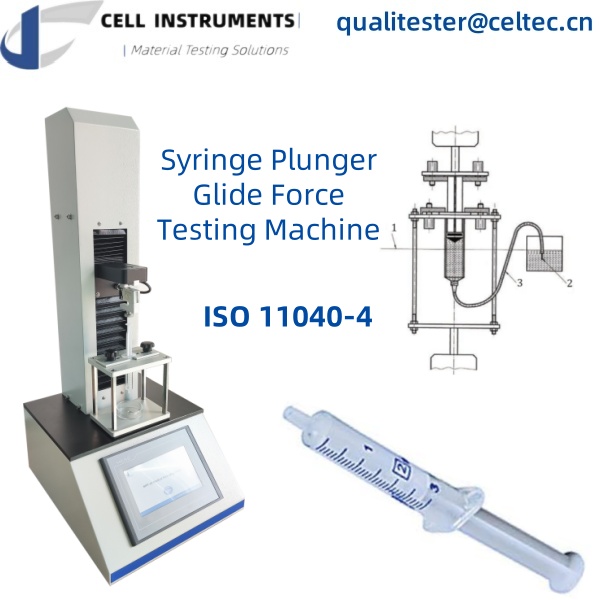Syringe Functionality Testing
Break Loose Force and Glide Force
Glide force refers to the amount of force required to push a plunger inside a syringe barrel after the initial resistance is overcome. This initial resistance is known as the break loose force. Together, these parameters determine how easily and consistently a syringe can be operated. They are essential components of syringe functionality testing and especially important in evaluating the performance of pre-filled syringes.
In ISO 11040-4, Annex E defines the glide force test as a means to evaluate lubrication quality (e.g., silicone oil) or the behavior of non-lubricated syringe systems. Poor glide force values can lead to delivery issues, increased injection pain, or failure in automated devices like autoinjectors.
Glide Force and Break Loose Force Testing
Syringe Break Loose Force Testing
Esta es la fuerza inicial necesaria para superar la fricción entre el tapón del émbolo y el cuerpo de la jeringa, esencialmente la fuerza necesaria para iniciar el movimiento del émbolo.
Prueba de fuerza de deslizamiento de la jeringa
Una vez superada la fuerza de desprendimiento, la fuerza de deslizamiento es la fuerza continua necesaria para mantener un movimiento suave del émbolo a lo largo del cuerpo de la jeringa. La región de prueba de fuerza de deslizamiento es la sección entre la región de desprendimiento y el aumento brusco de fuerza al final del recorrido.
ISO 11040-4: Standard for Glide Force Pre-Filled Syringe Testing
El ISO 11040-4 standard, Prefilled Syringes – Part 4: Glass barrels for injectables and sterilized subassembled syringes ready for filling, offers a detailed framework for testing glide force in pre-filled syringes. According to Annex E:
- The test speed is typically 100 mm/min, but can be adjusted by agreement.
- A high sampling rate (≥500 Hz) is recommended to capture accurate peak forces.
- Glide force is evaluated in a region that starts after the break loose and ends before the sharp increase in resistance at the barrel’s end.
- El break loose and glide force testing results help in identifying inconsistencies in lubrication or design that may compromise syringe performance.
Test materials include:
- Empty sterilized syringes, with or without lubrication.
- Plunger stoppers y rods, selected based on agreed specifications.
Procedimiento para la prueba de fuerza de deslizamiento y de desprendimiento
La prueba de fuerza de deslizamiento sigue un procedimiento definido para garantizar resultados precisos y confiables. A continuación se muestra una versión simplificada del proceso de prueba:
- Paso 1:Inserte el tapón del émbolo en el cuerpo de la jeringa vacía utilizando un tubo de ventilación o un método de tapón al vacío.
- Paso 2:A continuación, se fija la varilla del émbolo al tapón del émbolo.
- Paso 3:La jeringa se coloca en una placa adaptadora adecuada en un dispositivo de medición de fuerza (máquina de pruebas de tracción y compresión).
- Paso 4:Se establece una velocidad de prueba designada, normalmente alrededor de 100 mm/min.
- Paso 5:Se realiza la prueba y se mide la fuerza necesaria para mover el émbolo. La fuerza de deslizamiento es la región entre la fuerza de desprendimiento y el punto donde la fuerza aumenta bruscamente al final del recorrido.
- Paso 6:Se prueban varias muestras para garantizar la consistencia.
Equipment for Glide Force and Break Loose Force Testing
To conduct reliable glide force and break loose force testing, precise and standards-compliant instruments are essential. The MST-01 Break Loose Glide Force Tester de Instrumentos celulares is engineered specifically for such tests. It supports multiple functionalities including:
- Glide force and break loose force pre-filled syringes pruebas
- Syringe sliding resistance
- Plunger actuation and pull-out force measurement
- Needle insertion and bonding strength tests
Key features of MST-01 Break Loose Glide Force Tester
For quality control laboratories or manufacturers looking to streamline their syringe glide force testing, MST-01 offers a highly adaptable, accurate, and compliant solution.
Errores comunes en las pruebas de fuerza de planeo
Si bien la prueba de fuerza de deslizamiento es sencilla, existen errores comunes que pueden afectar la precisión de los resultados:
- Velocidad de prueba incorrecta:La velocidad de prueba debe coincidir con las condiciones en las que se utilizará la jeringa. Una velocidad de prueba de 100 mm/min es la estándar, pero pueden requerirse velocidades diferentes según las necesidades del cliente o las especificaciones del producto.
- Instalación incorrecta del tapón del émbolo:Asegurarse de que el tapón del émbolo esté instalado de forma segura y correcta es fundamental para realizar pruebas precisas. La desalineación puede generar resultados inconsistentes.
- Baja tasa de muestreo:Una frecuencia de muestreo baja (por debajo de 100 Hz) puede no detectar con precisión las fuerzas máximas, lo que puede generar mediciones incorrectas de la fuerza de deslizamiento.
Preguntas frecuentes sobre la prueba de fuerza de deslizamiento de la jeringa
1: ¿Cuál es la diferencia entre la fuerza de desprendimiento y la fuerza de deslizamiento?
La fuerza de liberación es la fuerza necesaria para iniciar el movimiento, mientras que la fuerza de deslizamiento es la fuerza necesaria para mantener un movimiento constante del émbolo.
2. ¿Cuál es el propósito de la prueba de fuerza de deslizamiento de la jeringa?
La prueba de fuerza de deslizamiento de la jeringa mide la resistencia al movimiento del émbolo dentro del cilindro de la jeringa, lo que ayuda a evaluar la calidad de la lubricación y la usabilidad general de la jeringa.
3. ¿Qué equipo se necesita para la prueba de fuerza de deslizamiento de la jeringa?
A universal tensile and compression testing machine, such as the MST-01 Break Loose Glide Force Tester, is required to perform the glide force test accurately.
4. ¿Cómo interpreto los resultados de la prueba de fuerza de planeo?
Los resultados de la prueba se interpretan comparando la fuerza de deslizamiento medida con límites aceptables predeterminados. Las fuerzas de deslizamiento máximas y promedio deben estar dentro de estos límites para que la jeringa se considere compatible.
Productos relacionados
MST-01 Break Loose Glide Force Tester


